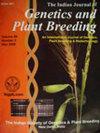水稻WA-CMS系统育性恢复中Rf基因的分子标记
IF 1
4区 生物学
Q3 PLANT SCIENCES
引用次数: 0
摘要
育性恢复性状的筛选过程包括与一组细胞质雄性不育系的杂交试验,以及对F1杂种花粉和小穗育性的评估。在本研究中,利用来自杂交的APMS 6A×RP 5933-123的F2定位群体来定位Rf基因。还对F2群体的花粉和小穗育性百分比进行了遗传分析。Chisquare(?2)分析表明,育性恢复性状符合预期的双基因比例。通过本体分离分析(BSA),可能含有Rf基因的区域位于10号染色体上。10号染色体RM304、RM258和9号染色体RM23958的SSR标记在两组可育体和不育体之间表现出明显的多态性。基于BSA连锁分析和F2群体、花粉和小穗育性分析以及Rf连锁标记的分子筛选结果,得出结论:位于10号染色体的Rf4基因和9号染色体的次要影响基因对新获得的恢复系RP5933育性恢复性状的90%起主要作用。这些发现可能对杂交水稻育种有用。本文章由计算机程序翻译,如有差异,请以英文原文为准。
Molecular tagging of Rf genes for the fertility restoration of WA-CMS system by bulk segregant analysis in rice
The process of screening for fertility restoration trait involves test crossing with a set of cytoplasmic male sterile (CMS) lines and evaluation of F1 hybrids for pollen and spikelet fertility. In the present study, F2 mapping population derived from a cross, APMS 6A × RP 5933-123 was utilized to map Rf genes. The F2 population was also genetically analysed for pollen and spikelet fertility percentage. Chisquare (?2) analysis to showed that the fertility restoration trait followed expected digenic ratio. By bulk segregant analysis (BSA) likely Rf genes containing regions were located on chromosome 10. The SSR markers viz., RM304, RM258 located on chromosome 10 and RM23958 located on chromosome 9 showed clear polymorphism between two groups of fertile and sterile bulks. Based on BSA linkage analysis and F2 population, pollen and spikelet fertility analysis along with molecular screening results of Rf linked markers, it is concluded that Rf4 gene located on chromosome 10 is playing major role and contributing to 90% of fertility restoration trait of newly derived restorer line RP5933 along with minor effect genes from chromosome 9. The findings may be useful for rice hybrid breeding.
求助全文
通过发布文献求助,成功后即可免费获取论文全文。
去求助
来源期刊

Indian Journal of Genetics and Plant Breeding
PLANT SCIENCES-
CiteScore
1.80
自引率
10.00%
发文量
0
审稿时长
6-12 weeks
期刊介绍:
Advance the cause of genetics and plant breeding and to encourage and promote study and research in these disciplines in the service of agriculture; to disseminate the knowledge of genetics and plant breeding; provide facilities for association and conference among students of genetics and plant breeding and for encouragement of close relationship between them and those in the related sciences; advocate policies in the interest of the nation in the field of genetics and plant breeding, and facilitate international cooperation in the field of genetics and plant breeding.
 求助内容:
求助内容: 应助结果提醒方式:
应助结果提醒方式:


